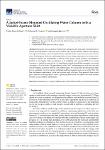A Jacket-Frame Mounted Oscillating Water Column with a Variable Aperture Skirt
| dc.contributor.author | Pérez-Collazo, C | |
| dc.contributor.author | Greaves, DM | |
| dc.contributor.author | Iglesias, G | |
| dc.date.accessioned | 2024-01-19T11:37:56Z | |
| dc.date.issued | 2024-01-18 | |
| dc.identifier.issn | 2077-1312 | |
| dc.identifier.issn | 2077-1312 | |
| dc.identifier.other | ARTN 2383 | |
| dc.identifier.uri | https://pearl.plymouth.ac.uk/handle/10026.1/21915 | |
| dc.description.abstract |
During the last decade jacket-frames have emerged as the main kind of substructure for bottom-mounted offshore wind farms in intermediate water depths. With the offshore wind industry moving towards deeper waters, the predominance of jacket-frames is expected to increase in future years. Multipurpose platforms combining wind and wave energy are proposed as an innovative solution to enhance the sustainability of offshore wind energy. In this research, a multipurpose platform is investigated with a novel feature in its oscillating water column (OWC) wave energy converter—a variable geometry skirt. A comprehensive physical modelling campaign was carried out using a 1:50 scale model. The performance of the OWC and its interaction with the wave field were investigated under four different skirt aperture angles. It was found that the skirt aperture angle plays a significant role in the capture-width ratio and the pneumatic mean power of the OWC. The best performance was obtained with a skirt aperture angle of 140 deg. More generally, these results prove that the variable-geometry skirt is a promising innovation for hybrid wave-wind systems mounted on jacket-frame substructures. | |
| dc.format.extent | 2383-2383 | |
| dc.language | en | |
| dc.publisher | MDPI AG | |
| dc.subject | hybrid wind-wave energy | |
| dc.subject | oscillating water column (OWC) | |
| dc.subject | offshore wind | |
| dc.subject | physical modelling | |
| dc.title | A Jacket-Frame Mounted Oscillating Water Column with a Variable Aperture Skirt | |
| dc.type | journal-article | |
| dc.type | Article | |
| plymouth.issue | 12 | |
| plymouth.volume | 11 | |
| plymouth.publisher-url | http://dx.doi.org/10.3390/jmse11122383 | |
| plymouth.publication-status | Published online | |
| plymouth.journal | Journal of Marine Science and Engineering | |
| dc.identifier.doi | 10.3390/jmse11122383 | |
| plymouth.organisational-group | |Plymouth | |
| plymouth.organisational-group | |Plymouth|Research Groups | |
| plymouth.organisational-group | |Plymouth|PRIMaRE Publications | |
| plymouth.organisational-group | |Plymouth|Faculty of Science and Engineering | |
| plymouth.organisational-group | |Plymouth|Faculty of Science and Engineering|School of Engineering, Computing and Mathematics | |
| plymouth.organisational-group | |Plymouth|Research Groups|Marine Institute | |
| plymouth.organisational-group | |Plymouth|REF 2021 Researchers by UoA | |
| plymouth.organisational-group | |Plymouth|Users by role | |
| plymouth.organisational-group | |Plymouth|Users by role|Academics | |
| plymouth.organisational-group | |Plymouth|REF 2021 Researchers by UoA|UoA12 Engineering | |
| plymouth.organisational-group | |Plymouth|Users by role|Researchers in ResearchFish submission | |
| plymouth.organisational-group | |Plymouth|Research Groups|COAST Engineering Research Group | |
| plymouth.organisational-group | |Plymouth|REF 2028 Researchers by UoA | |
| plymouth.organisational-group | |Plymouth|REF 2028 Researchers by UoA|UoA12 Engineering | |
| dcterms.dateAccepted | 2024-01-15 | |
| dc.date.updated | 2024-01-19T11:37:55Z | |
| dc.rights.embargodate | 2024-1-20 | |
| dc.identifier.eissn | 2077-1312 | |
| rioxxterms.versionofrecord | 10.3390/jmse11122383 |


